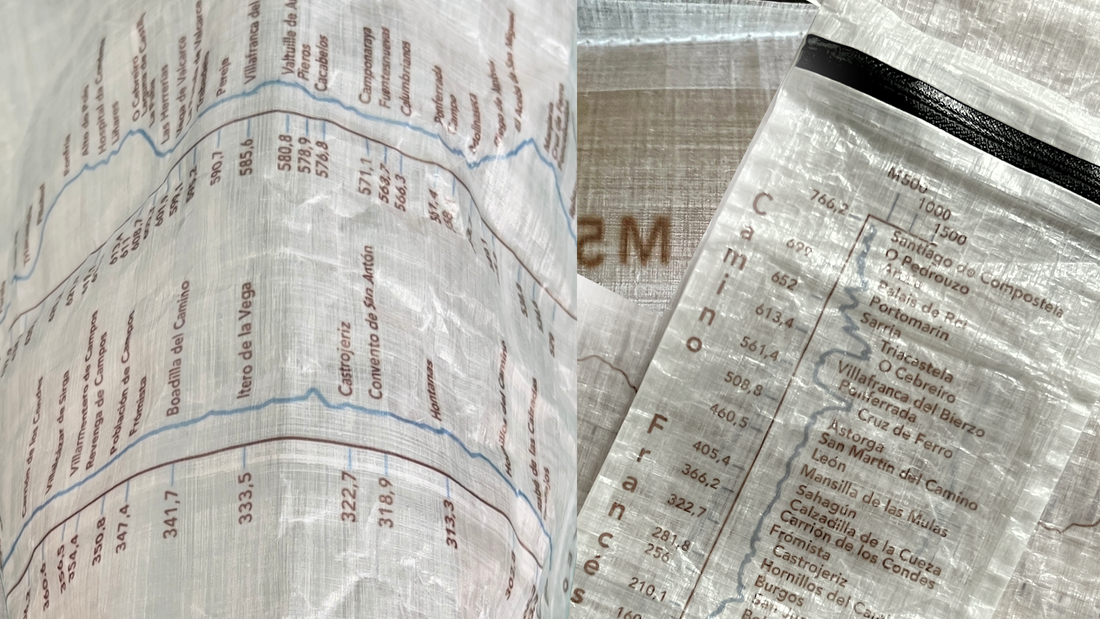
Is Dyneema® Worth It? A Long Walk in the Rain Says Yes
Share
When I first came across Dyneema® Composite Fabric (DCF)—a waterproof laminate often used in ultralight gear—I have to admit it: I was skeptical. It looked like a pricey piece of plastic that could easily rip and felt far too expensive to casually experiment with on projects. But as someone who spends a lot of time outdoors, I decided to gamble on performance and bought a yard each of the 0.67 oz and 1.43 oz versions. As my grandmother used to say, “Cheap things always end up expensive.”
Around that time, I was preparing for the Camino Portugués. I needed a waterproof pouch for my wallet, plus a few roll-top bags for clothing and my sleeping bag. After stitching, I seam-sealed the DCF carefully—except for a one-inch section that I intentionally left unsealed in one of the bags, just to test how it would perform. I also wondered if the added cost of seam-sealing tape would really be worth it.
Then came the Camino. December into January. Weeks of near-constant rain during a long walk—not only through Portugal, but also during the week from Santiago de Compostela to Fisterra, which included a three-day return to Santiago. At that point, I had walked close to 10,000 km across various Caminos, and this was the first time my patience was genuinely tested by the weather. It was the heart of winter—the darkest days of the year—and nothing seemed to dry.
One especially brutal day, I arrived at the albergue in Redondela, Spain, after walking more than 30 km in torrential rain. Everything—my Gore-Tex® jacket, shoes, and waterproof 210D Gridstop-with-Dyneema® backpack—was soaked through. My faith in fully impermeable gear was shaky. I braced myself to find my documents ruined. But when I went to show my credentials at registration, I unzipped my DCF valuables pouch with a wet, freezing hand—and everything inside was completely dry. Even my clothing in the roll-top bag was fine—except, of course, for the one inch that I hadn’t fully sealed. That small damp spot where my sleeping bag had pressed against the seam proved just how important that final bit of sealing really is.
That trip convinced me: Dyneema® Composite Fabric isn’t just hype. It’s lightweight, waterproof, and dependable—even in extreme conditions. It may be expensive, but when everything else fails and your essentials stay dry, it’s worth every penny and permanent wrinkle. And rather than fighting the crinkles, I like to think of them like the Camino itself—every mark tells a story.
What is Dyneema®? And What’s Dyneema Composite Fabric (DCF)?
Dyneema® is a branded ultra-high-molecular-weight polyethylene (UHMWPE)—an extremely strong, lightweight fiber.
Dyneema® Composite Fabric (DCF) is a laminate that sandwiches Dyneema® fibers between waterproof polyester films. Though they share a name, DCF is not a woven fabric—it's a nonwoven composite designed for ultralight waterproof applications.
Key Properties
-
15× stronger than steel (by weight) — and light enough to float
-
Inherently waterproof — DCF achieves ~20,000 mm hydrostatic head, without needing PFAS-based DWR coatings
- Extremely tear-resistant — up to 3× stronger than traditional ultralight fabrics
Notable Limitations
- Needs proper seam sealing — stitched areas will leak if not sealed (as I learned!)
- Prone to abrasion — outer films can scuff or tear under rough contact
- Crinkles and creases — they’re permanent but add charm
- High upfront cost — material + finishing (like seam tape) can add up
- End-of-life disposal — currently not recyclable in standard waste streams
Is Dyneema® Sustainable? It’s Complicated.
Dyneema® Composite Fabric isn’t biodegradable or easily recyclable. Compared to many waterproof fabrics, it can be a responsible choice when used in durable, repairable gear that replaces short-lived plastic solutions. It has some advantages:
- No PFAS or chemical DWR needed
-
Waterproof by design, not by treatment
- Bio-based Dyneema® options available — made partly from wood and pulp industry by-products (ISCC-certified)
- Produced with 100% renewable electricity
- Long-lasting if cared for
-
Pilot recycling programs are in development
Why Pilgrims Might Consider Dyneema® Composite Fabric
If you’re walking a pilgrimage like the Camino de Santiago, where gear needs to be lightweight, waterproof, and durable for weeks, DCF can be worth the investment.
Yes, plastic bags work—for a while. But when they fail (and they often do), the consequences can be serious. DCF pouches and roll-tops, properly sealed, provide lasting protection.
Just be sure to:
- Seam-seal all stitched areas (don’t skip even a centimeter!)
- Handle with care to avoid abrasion
- Embrace the wrinkles—like your Camino steps, they’re part of the journey
Final Thoughts
Dyneema® Composite Fabric isn't perfect. It’s not cheap. It’s not biodegradable. But it does offer a high-performance, PFAS-free, low-bulk alternative to heavier waterproof materials. Bio-based Dyneema® options reduce fossil fuel use—check your source. With careful sewing and thoughtful use, it’s become one of the most trustworthy fabrics I’ve ever walked with in harsh conditions.
And yes, every crinkle tells a story.
Sources: dyneema.com, dyneema.com/sustainability

Taking a short break from the rain at a bus stop.

Despite performing well for two weeks, my waterproof pants failed in torrential rain.

Walking from Muxía to Fisterra—yes, it's raining.
